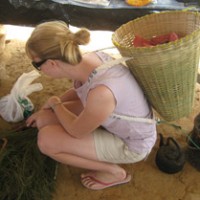In Bangkok, you’re often struck with the feeling one gets from seeing an elephant roaming the streets with a reflector on his tail, earning money for someone by selling bananas and sugarcane to tourists who feed it back to him.
This sight is a confusing one, begging the question of where the elephant’s family members are, and whether or not they are doomed in a parallel universe of filthy streets, the stench emitting from Tuk Tuks and open sewers, living as a slave to bananas and sugarcane.
The reality of the situation is that the city elephant’s extended family members may be in other parts of the country working as beasts of burden, or trapped in zoos. Some of the rare few remain in the wild, struggling to survive as what they are.
In the western province of Kanchanaburi, wild baby elephants have shown up in village plantations in their relentless search for food. These elephants that generally stay in herds of 10 or so seem to have been abandoned. They navigate the forest alone and starving, in a parallel universe to their cousins in the city.
As a response, the forest temple established by the renowned Pra-Ajahn Mitsuo Gavesako and the associated foundation has taken a part in assisting these orphaned elephants. They have begun the process of cultivating a banana plantation to provide food for the wandering elephants.
The quirk of banana trees is their ability to establish the ecological balance of the forest through increasing moisture and mitigating wildfires through their absorption of water. The inside of the tree trunks works as a sponge, retaining water which the animals can also drink from.
When ripe, banana trees release a powerful odor that animals can smell from a long distance. Elephants do not eat the green bananas, only the ripe ones, as well as the soft and juicy tree trunk, which they peel back, eating only the middle part. The trunk leftovers become food for other animals such as bears, hawks, and birds, among others. The elephants are a sort of pioneer for other animals, leaving a clear trail for them to follow.
A team of volunteers from the Pra Ajahn Mitsuo Gavesako Foundation have joined together to plant the banana trees for the elephants on degraded lands in Kanchanaburi province. In so doing, they are reforesting the land and dually providing a means of subsistence to the lost elephants of the jungle.






Read 0 comments and reply